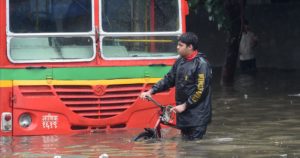3JULY2019 STATE OBSERVER
 Barely a week into the monsoon, Mumbai was on its knees once again on Monday, its vital systems crumbling under the impact of three days of torrential rain. This has happened year after year for over a decade, and the municipal corporation’s inability to prevent chaos every monsoon sends out one message: there is no political will to acknowledge the reality of climate change and equip the city to cope with it.Between Monday and Tuesday morning, most parts of the Mumbai metropolitan region received around 400 mm of rain – the heaviest since the devastating deluge of July 26, 2005, which left more than 1,000 people dead.ADVERTISEMENTOvernight, at least 21 people were killed in a wall collapse caused by heavy rains in the suburb of Malad, and more than 10 were injured. Two men trapped in a car in Malad subway drowned in flood waters. At least 1,000 people had to be rescued from heavy flooding in Kurla. As local trains, long-distance trains and flights were either cancelled or delayed, civic authorities declared a public holiday on Tuesday. The meteorological department has warned that there will be intense rainfall for two more days.As the city received at least 85% of its average rainfall for June in just four days, Municipal Commissioner Praveen Pardeshi blamed “climate change and changed geographical conditions” for the water-logging at several places. While this may seem unprecedented, these bursts of extreme rainfall are no longer an anomaly, and should no longer be used as an excuse by the civic body for its lack of preparedness.For several years, climate change researchers have predicted that extreme precipitation events – bouts of intense rainfall concentrated in a specific region over a short period of time – are set to become the new normal. These extreme weather events are linked to rising land and sea temperatures caused by global warming.In 2006, scientists from the Indian Institute of Tropical Meteorology in Pune found that intense rainfall had increased by 10% every decade since the 1960s. Last year, the Indian Institute of Technology, Bhubaneshwar, reaffirmed that rising surface temperatures across India will increase rainfall intensitADVERTISEMENTMumbai has been living these extreme rain events every year since the catastrophic floods of July 2005. Since then, the city’s municipal corporation has spent more than Rs 2,500 crore to implement the Brihanmumbai Storm Water Disposal System or BRIMSTOWAD – a project to revamp Mumbai’s colonial-era drainage system. But BRIMSTOWAD remains incomplete, drains remain clogged with trash in several parts of the city, and those who suffer the most as a result are inevitably residents of slums and low-income areas.Mumbai’s civic authorities have also consistently undermined their own flood management efforts by allowing the city’s natural drainage systems – mangroves, wetlands, salt pan lands – to be encroached upon by unchecked construction. The latest project to concretise these natural flood buffers is the Rs 10,000-crore coastal road planned along the city’s western coastline. The road will benefit just a fraction of the city’s population, but the civic body allowed construction to begin despite warnings and protests from ecologists and If Mumbai – and other cities across India – want to truly act in the interests of their residents, it is time for civic authorities to build infrastructure that is appropriate for the new realities of climate change.Support our journalism by subscribing to Scroll+ here. We welcome your comments at [email protected].
Barely a week into the monsoon, Mumbai was on its knees once again on Monday, its vital systems crumbling under the impact of three days of torrential rain. This has happened year after year for over a decade, and the municipal corporation’s inability to prevent chaos every monsoon sends out one message: there is no political will to acknowledge the reality of climate change and equip the city to cope with it.Between Monday and Tuesday morning, most parts of the Mumbai metropolitan region received around 400 mm of rain – the heaviest since the devastating deluge of July 26, 2005, which left more than 1,000 people dead.ADVERTISEMENTOvernight, at least 21 people were killed in a wall collapse caused by heavy rains in the suburb of Malad, and more than 10 were injured. Two men trapped in a car in Malad subway drowned in flood waters. At least 1,000 people had to be rescued from heavy flooding in Kurla. As local trains, long-distance trains and flights were either cancelled or delayed, civic authorities declared a public holiday on Tuesday. The meteorological department has warned that there will be intense rainfall for two more days.As the city received at least 85% of its average rainfall for June in just four days, Municipal Commissioner Praveen Pardeshi blamed “climate change and changed geographical conditions” for the water-logging at several places. While this may seem unprecedented, these bursts of extreme rainfall are no longer an anomaly, and should no longer be used as an excuse by the civic body for its lack of preparedness.For several years, climate change researchers have predicted that extreme precipitation events – bouts of intense rainfall concentrated in a specific region over a short period of time – are set to become the new normal. These extreme weather events are linked to rising land and sea temperatures caused by global warming.In 2006, scientists from the Indian Institute of Tropical Meteorology in Pune found that intense rainfall had increased by 10% every decade since the 1960s. Last year, the Indian Institute of Technology, Bhubaneshwar, reaffirmed that rising surface temperatures across India will increase rainfall intensitADVERTISEMENTMumbai has been living these extreme rain events every year since the catastrophic floods of July 2005. Since then, the city’s municipal corporation has spent more than Rs 2,500 crore to implement the Brihanmumbai Storm Water Disposal System or BRIMSTOWAD – a project to revamp Mumbai’s colonial-era drainage system. But BRIMSTOWAD remains incomplete, drains remain clogged with trash in several parts of the city, and those who suffer the most as a result are inevitably residents of slums and low-income areas.Mumbai’s civic authorities have also consistently undermined their own flood management efforts by allowing the city’s natural drainage systems – mangroves, wetlands, salt pan lands – to be encroached upon by unchecked construction. The latest project to concretise these natural flood buffers is the Rs 10,000-crore coastal road planned along the city’s western coastline. The road will benefit just a fraction of the city’s population, but the civic body allowed construction to begin despite warnings and protests from ecologists and If Mumbai – and other cities across India – want to truly act in the interests of their residents, it is time for civic authorities to build infrastructure that is appropriate for the new realities of climate change.Support our journalism by subscribing to Scroll+ here. We welcome your comments at [email protected].


